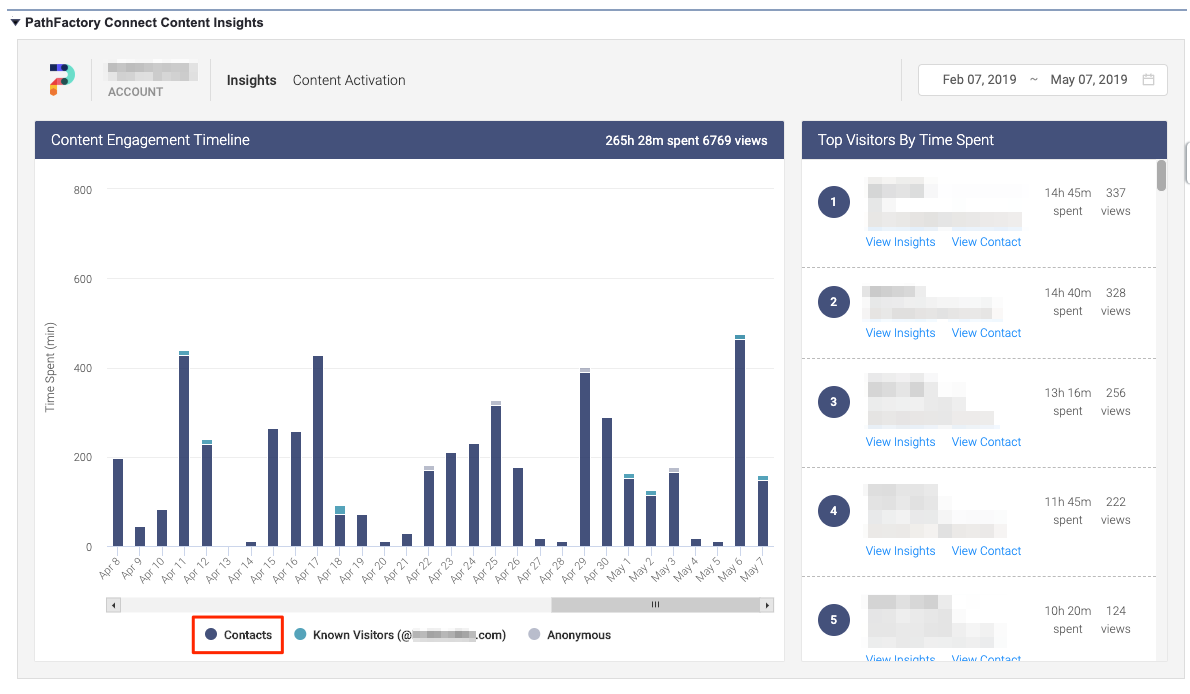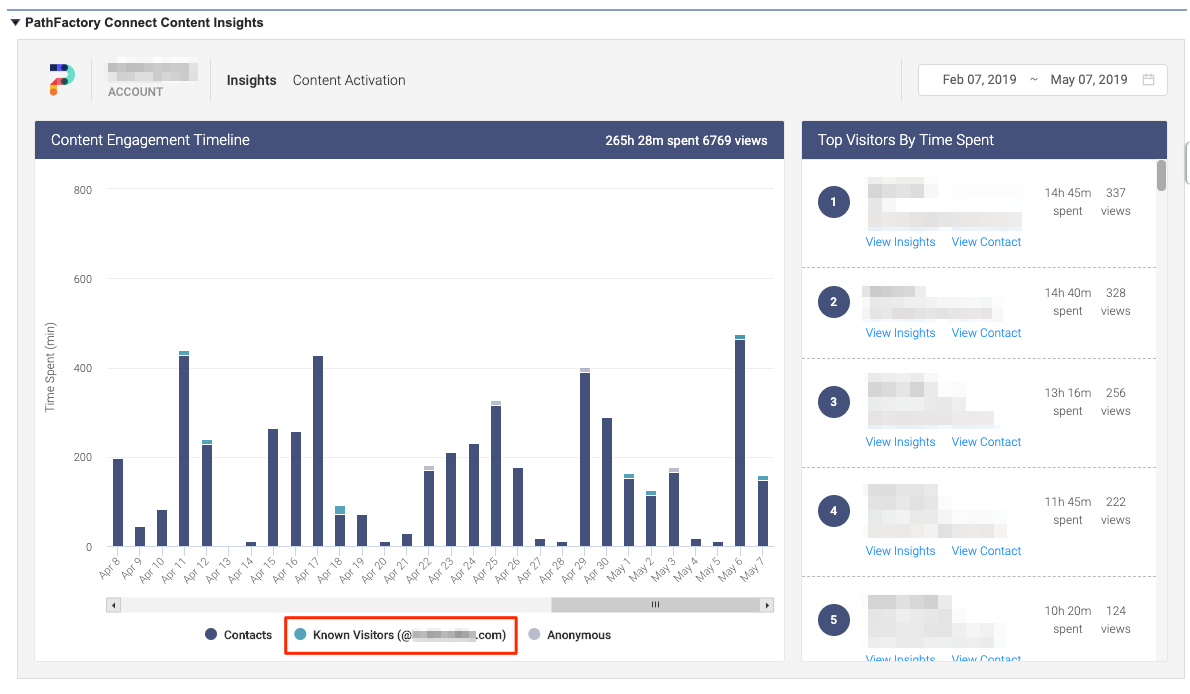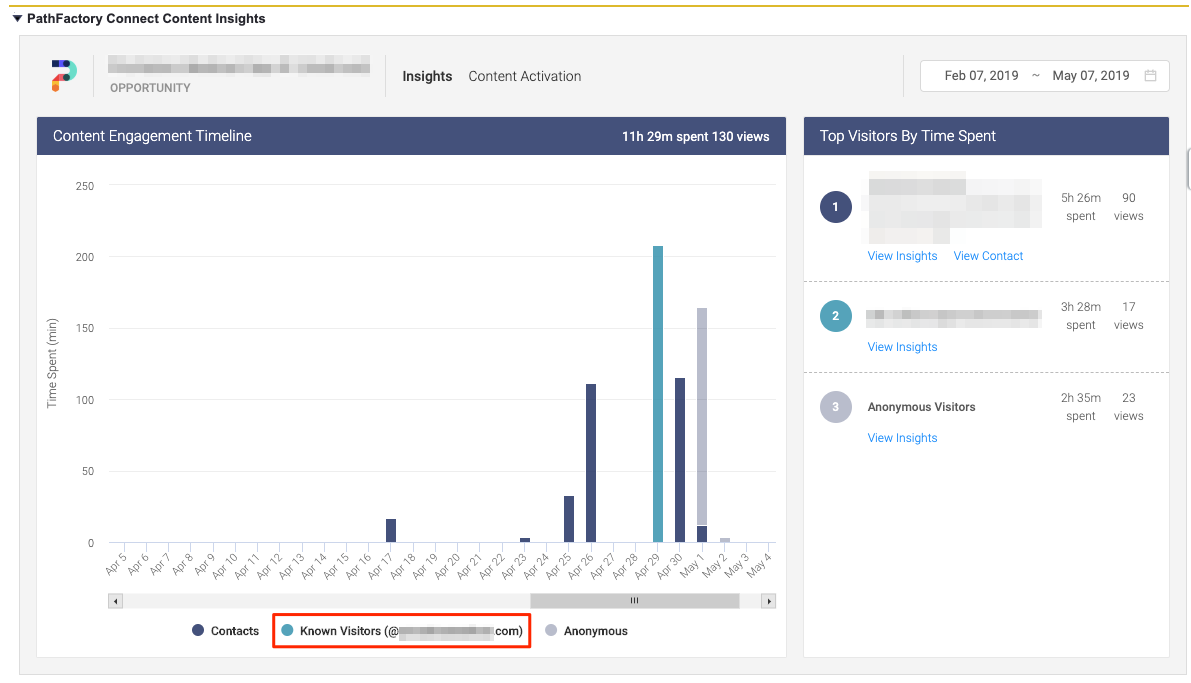Why do some of my accounts, leads, and contacts have no PathFactory engagement data in Salesforce?
If you are running campaigns on channels that target your unknown audience eg. social, display, then most of your visitors will be anonymous, as they are yet to be identified either by a visitor cookie from your MAP, or a form fill.
I’m a BDR/AE/sales rep, how do I ensure that content engagement appears within Salesforce when I send out PathFactory Content Tracks?
Ensuring you are tracking all of your prospects engagement from marketing channels and from your sales outbound emails is a way to have better and more relevant conversations with your prospects.
When emailing a Content Track to your prospect, the email must be tracked. Your marketing team will send tracked emails via MAP (eg. Eloqua, Marketo), and you can send a tracked email from a Sales Outbound tool (eg. PathFactory for Sales, Outreach), or by simply choosing a Plain Text Tracking from the drop down list within the Content Activation inside PathFactory for Sales.
|
Note
|
Click here to learn more about using PathFactory for Sales. |
How do I set default email tracking type?
Navigate to the Settings tab within PathFactory for Sales (in the Salesforce application).
Will anonymous visitors be displayed?
Yes, unknown visitors will appear within an Account’s engagement summary, and will be marked as anonymous.
Are the dashboards visible to all of our Salesforce users?
All reports are visible to all users who have access to the Account, Opportunity, Lead, or Contact pages.
Can I export or download this data?
Engagement data is only available for download from within PathFactory Analytics, and not via Salesforce.
What CRMs are supported?
Currently, Salesforce is supported for the PathFactory for Sales integration.
What engagement data is shown on the account record?
PathFactory for Sales uses the contacts that are associated with an account to determine what engagement data to return for that account. The data returned is based on the following logic:
- PathFactory for Sales returns engagement data for all contacts with a valid email address that are associated to the account. This data will show up within the Contacts grouping (dark blue) in the PathFactory for Sales chart on Account records.

Content Highlights - PathFactory for Sales determines a primary email domain for your account from the account’s list of contacts. This is done by determining the most frequently occurring email domain from this list of contacts. Engagement data for all known visitors in addition to the account’s contacts from that email domain is also returned for the account. This data will show up within the Known Visitors grouping (teal) in the PathFactory for Sales chart on Account records.

Known Visitors

PathFactory for Sales also uses the primary email domain to determine any anonymous visitors from this account that have engaged with your content in PathFactory. This data is displayed as the Anonymous grouping (gray) in the PathFactory for Sales chart on Account records.
What engagement data is shown on the opportunity record?
PathFactory for Sales uses the contacts that are associated with an opportunity to determine what engagement data to return for that account. The data returned is based on the following logic:
- PathFactory for Sales returns engagement data for all contact roles with a valid email address that are associated to the opportunity. This data will show up within the Contacts grouping (dark blue) in the PathFactory for Sales chart on Opportunity records.

Contacts - PathFactory for Sales determines a primary email domain for your account from the opportunity’s list of contacts. This is done by determining the most frequently occurring email domain from this list of contacts. Engagement data for all known visitors in addition to the opportunity’s contacts from that email domain is also returned for the account. This data will show up within the Known Visitors grouping (teal) in the PathFactory for Sales chart on Opportunity records.

Known Visitors
- PathFactory for Sales also uses the primary email domain to determine any anonymous visitors from this opportunity that have engaged with your content in PathFactory, and returns that data within the Anonymous grouping (gray) in the PathFactory for Sales chart on Opportunity records.

Anonymous Visitors
What engagement data is shown on the PathFactory for Sales Dashboard?
The PathFactory for Sales tab provides insights for engagement data across your entire PathFactory instance with a focus on helping your sales team find your most engaged accounts and contacts. The engagement data returned is based on the following logic:
- Engagement data for all of your known visitors for your linked PathFactory instance is returned.
- PathFactory for Sales attempts to associate these known visitors by their email addresses to your existing contacts within your CRM.
- If an association is made, PathFactory for Sales uses the associated contact’s account as the known visitor’s account.
- If an association cannot be made, PathFactory for Sales uses the email domain of the known visitor as the known visitor’s account.
- These visitors are likely to exist within your CRM as a lead.
- The data for all of these known visitors is grouped by the known visitor’s account and displayed within the Accounts chart.
- Successfully associated accounts are labeled with their account name.
- All other accounts are labeled with the email domain of their associated visitors.
- For successfully associated accounts, once clicking on their bar in the chart, you will be able to see additional details on the account, the account’s contacts, and any opportunities against that account in the Contacts & Opportunities pane.
What type of integration is required for PathFactory for Sales?
PathFactory for Sales is installed into Salesforce as a managed package containing Visualforce pages and an Apex Controller. The Visualforce pages use iframes to render the PathFactory for Sales application hosted on a PathFactory server. PathFactory integrates with SFDC data using the Visualforce page and Apex controllers. It does not use the SFDC SOAP API and only uses the SFDC REST API to make authentication calls against the SFDC user’s access token and will not consume any SFDC API call quotas.
What encryption protocol is used to protect data in transit?
Data in transit is secured with TLS 1.2 encryption protocol.
How is the connection authenticated? Are there any other authentication methods available to improve security?
SFDC users are authenticated through the session ID token variable that is available in Visualforce pages. PathFactory determines the identity of the user by using this token in an API call against Salesforce’s OpenID Connect userinfo endpoint.
After installing the managed package, PathFactory for Sales is linked to the SFDC instance through an install page that asks a user to authenticate with their PathFactory credentials. This provides us with information on your SFDC instance (your Organization ID) that we use to verify against the Organization ID returned of the current user from the userinfo endpoint.
What permissions/Auth Scopes are required?
The OAuth scope required is “Access your basic information”.
What is PathFactory for Sales installing into my instance?
The PathFactory for Sales package contains the following to make the application work:
- An Apex controller that is used to read from the Contact, Lead, Account, and Opportunity objects
- Visualforce Pages that can be added to the layouts for the following objects: Account, Contact, Lead, Opportunity. NOTE: These pages do not use the Apex controller and leverage data provided directly from Visualforce page merge fields
- A Visualforce Page (PathFactory for Sales Dashboard) that can be added as a tab. NOTE: This page uses the Apex controller
How are permissions managed for PathFactory for Sales?
There are no permission requirements for the package to work. Permissions will primarily be defined with regards to the users/roles/permission sets that can view/access the various Visualforce pages.
Views: 101
